For a long time now I have been promising to write an article about how to teach a child to distinguish colors and about how we did it with Taisiya. Judging by the number of questions I receive, this topic interests many mothers. This is not surprising, because knowledge of colors is an integral part of a baby’s sensory development. Acquaintance with color significantly expands a child’s understanding of the world and allows him to classify all surrounding objects in another way - by color. In addition, the ability to distinguish colors opens up a new layer of interesting educational games for the child.
When does a child begin to distinguish colors?
Experts say that for a child, the world takes on colors within the first 3-4 months of life. Indeed, a child can pay attention to contrasting patterns and react differently to rattles of different colors, but, of course, it is too early to talk about conscious separation of colors at this age. The ability to find a certain color among others, and even more so to name colors, appears in a child much later, not earlier than 1-1.5 years . Well, the exact timing depends solely on whether you pay attention to studying colors with your child.
You can name colors while playing with your baby for up to a year, and there will be no harm from it. Well, after a year, you can introduce special “color” games, which will be discussed in this article. These games are also suitable for 2-3 year old children who are still confused about the names of colors.
A child's readiness to remember color names can be very easily tested. When playing with cubes (construction sets, balls in a dry pool...), take, for example, a red cube and ask your child to find exactly the same one. If the child understood you and coped with the task, we can say that he distinguishes colors and is ready to learn their names.
Color in nature
If you imagine the color green, then young grass, as well as tree foliage, almost immediately appears in your memory. Many of us remember the spring season, which is associated with growth and freshness.
The color green is perceived calmly, so it can have a beneficial effect on the entire body as a whole. Different shades of green have different interpretations. In particular, the coniferous tone is stability, strength, and a confident life position. It is quite useful to learn what the color green means in psychology.
Especially if such addictions are observed in one of your relatives or friends. It happens that a person chooses a delicate shade, which has sage or moss. This means that the color will have a calming effect on him. Those who prefer malachite and emerald actually want to get rich.
Learning colors during everyday games and walks
Generally speaking, I am convinced that in order to teach a child to distinguish primary colors, there is no great need for special classes; it is enough just to regularly name the colors during your regular games. When you draw, be sure to pronounce the colors of the pencils; when building with cubes, construction sets, or mosaics, don’t forget to remember the shades of the details. The same applies to dressing, walking, sculpting, applique and your other favorite activities - in conversation, constantly name the colors of the objects and playing materials around you.

Just remember that “learning colors” does not mean that you have to constantly examine the child “Tell me what color it is”, “Show me where red is”, etc. A child, like any other person, does not like being tested on his knowledge, so at first just name the colors and answer your own questions: “Where is the yellow cube? Here he is!" “Let’s draw the grass with a green pencil.”
Love for the color green in general
Many fans of different shades of emerald, coniferous and others are interested in what the color green means in psychology. If a person prefers the color green, this indicates that his success in his career is largely due to luck. In addition, it is common for such a person to influence others. But such a person is very afraid of influence from the outside.
Also, green color in psychology means that these people can support their family quite well. Materially, everything looks good. But in their personal lives, they may well have all sorts of difficulties. At the same time, you should not put pressure on your partner, despairing when difficulties arise on the mutual part of life.
How to teach a child to distinguish colors? Games
1. Sorting by color
In “sorting” games, the child is required to divide objects into groups, focusing on their color, and you are also required to constantly voice the names of colors so that they are deposited in the baby’s head. What can you sort? Here are some game options:
- You can make a color sorter from any unnecessary box; just cover the box with colored paper and make a few slits. You can push mosaic pieces, multi-colored paper clips, buttons, etc. into the slots. Our sorter is made from a tea box and mosaic pieces.

- We sort the beads into bowls. Imagine with your child that the beads are candies that you need to treat your toy friends with. At the same time, the bear loves only green candies, and the lion cub only loves red ones, so you have to try very hard not to offend anyone
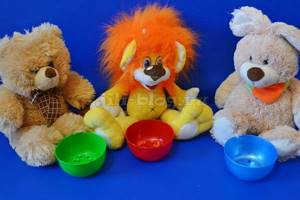
- We lay out toys and other small household items on the floor and invite the child to sort them into boxes of the appropriate color. Instead of boxes, you can prepare a large sheet of paper with different colored sections. Our game was much more dynamic when we distributed colored sections between Taisiya and her favorite toy. For example, Tasya took away all the red objects, and the doll Masha took away all the yellow ones.
- We find a mother hen for each testicle, focusing on color.
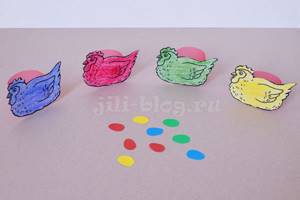
Place all the eggs in a cut-off plastic cup attached to the chicken.
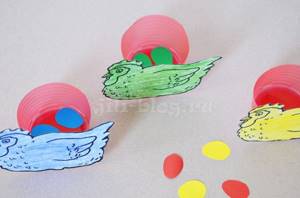
You can come up with a huge number of color sorting options; it’s impossible to list them all here. You can arrange colorful butterflies into flowers, fruits and vegetables into baskets, and place colorful little animals into houses... By the way, in the Game Box from readers there are also good options for color sorting.
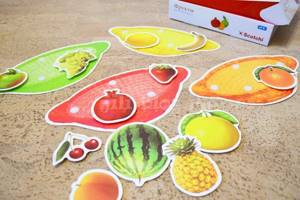
2. Games from the “Match a Pair” series
Games from the “Match a Pair” category are also well suited for learning colors. You can select lids for houses, caps for gnomes or clowns, housing for colorful people, etc.
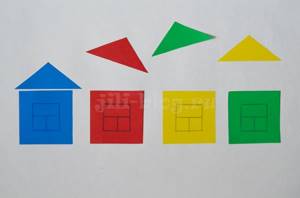
You can try this version of the game: lay out the incorrect version in front of your child in advance and ask him to correct the mistakes.
3. Color lotto
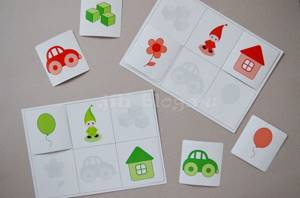
Games based on the lotto principle become interesting to children at about a little over a year old. Of course, for now the kids don’t play by adult rules, but simply match cards to the playing field with pictures.
In color lotto, the pictures on each playing field have only one color. (An example of a colored lotto can be DOWNLOADED HERE ). Therefore, to collect such a lotto, the child needs to select cards of a given color from the rest and place them correctly on the field.
In a more complicated version, you can simultaneously use 2-3 playing fields, and also learn to compare color and black and white images, as in the game “Dwarves and Houses” (Ozon, My-shop, Read) from the “School of the Seven Dwarfs”.
4. Colorful days
This method of introducing color is very popular now. It lies in the fact that within one day (and some even stretch out this pleasure for a whole week), the child very often “comes across” the same color, regularly hears its name and, accordingly, quickly remembers it. So, on red day, you and your baby can dress in red clothes, find all the red toys and even eat red fruits and vegetables. Of course, all this time you will remind your child what color is on your way. Here is a sample list of what you can do on a “colored” day:
- Together with the baby, we look at pre-selected toys of the color being studied;
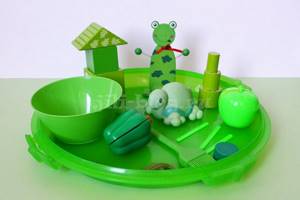
- We put on clothes in appropriate colors;
- We walk around the apartment looking for toys and other objects of the color being studied;
- While walking, we look for cars of the color we need;
- Playing with a color sensory box;
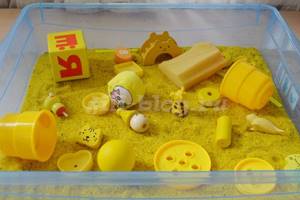
- We look at a book or cards with pictures of the color we need (cards);

- We sculpt from plasticine using only the color of that day. A similar approach can be used in drawing and appliqué;
- We play lotto of a given color (see above);
- We include in the menu products of the studied color (For example, for a red day the following are suitable: berries, tomatoes, red apples, pomegranates; for a green day : grapes, green olives, lettuce, peas, green apples, green beans, kiwi, avocado; for a yellow day : banana, corn, yellow apples, lemon, butter, cheese, pineapple; for white : rice, cottage cheese, semolina, milk; for orange : carrots, apricot, pumpkin, orange)
5. Doman cards “Colors”

To be honest, I believe that studying colors using Doman cards is the simplest and at the same time the most effective method, especially if we are not talking about too “traditional” tones. Doman classes require a minimum of effort and time, and the colors are almost guaranteed to be remembered, especially if the child has already had experience interacting with cards before. Just remember, in order for the learned colors not to fly out of the child’s head after a month, their names must be reinforced through other games (sorting by color, playing lotto, etc.).
What is also important: learn only those shades that you yourself distinguish and whose names you are really ready to use in your games and conversations. Don’t get carried away with sets like “100 flowers” from “Umnitsa”. What's the point of learning, for example, the shade purple, if when you encounter it in life, you yourself will most likely call it purple. This will only confuse the child.
My daughter and I started learning colors using cards at 1 year 4 months (by that time Tasya already knew and showed the four primary colors). Over the course of a few days, we memorized another 14 colors from the cards (a total of 18 in our arsenal) and began to mention their names in our games. For those who are skeptical about Doman’s method, I can assure that Taisiya to this day has not forgotten any of the colors she studied then!
Read more about the Doman method and the principles of training here. “Colored” cards can be DOWNLOADED HERE and purchased HERE.
6. Board games
After 2-2.5 years, board games can be used to consolidate knowledge about colors. For example, here is a good option:
Colorama (Ozon, My-shop) - I wrote about it here before.
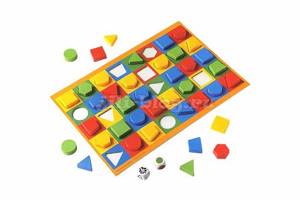
Psychology of colors in the interior
Most likely, you have already been able to verify from your own experience that the color of the walls of the room you are in can influence your mood and radically change it in both positive and negative directions. Of course, it is for this reason that you need to approach interior solutions with special attention.
It is obvious that color is one of the most important components of the environment, and it has the power to make adjustments to our well-being and mood in life. If you skillfully use colors and their combinations in the interior of a particular room, the result of such efforts will be a feeling of comfort and coziness. Otherwise, often being in a room with poorly chosen colors, you will only feel anxiety, apathy or despondency.
Surely, you have heard that dim, light and cool shades that have a minimum of contrast can visually “push apart” the walls of the room, and as a result it will seem more spacious than it really is. In turn, dark and warm shades visually narrow the space.
As you understand, a certain color can not only improve the interior of a home, but also ruin it. Study this issue carefully, study the nature of color and take note of the most successful color solutions. As we already mentioned, there are warm and cool colors, and the overall impression of the room will depend on which color you choose.
Involuntary drawings meaning. What do the pictures we unconsciously draw mean?
While talking on the phone, attending meetings, listening to lectures, many of us involuntarily begin to draw patterns, faces or geometric shapes on a piece of paper.
It turns out that such simple drawings can tell about a person’s mood or character traits. What exactly? Parade of numbers Those who like to draw numbers are concerned exclusively with material values. The first option is you figure out where and how you can make money. Second, you are thinking about how to pay off your debts. May there always be sun Are the pages of your notebook decorated with the sun or garlands? Paradoxically, your mood is by no means as rosy as these drawings. You lack warmth, care and attention. You dream of friendship and tenderness. Want some advice? Try to be around people more often in the near future. Call your friends, go to the cinema or for a walk with them, sit in a cafe. Then the sun will appear not only on paper, but also in your soul. Oh, these figures Squares, diamonds, triangles give out clear goals and firm convictions. Such figures are usually drawn by people who are used to openly expressing their point of view. They try not to give in to the enemy, have a practical mindset, well-developed logical thinking and are able to occupy a leadership position. Moreover, symmetrical forms mean a commitment to neatness and order, prudence and the ability to plan everything. At the same time, if the corners of the figures are drawn too sharply, this is a clear tendency towards aggression. Your problem is excessive concentration, which does not allow you to relax normally. Crosses without Os Crosses express feelings of guilt. Perhaps you offended someone or did not fulfill a promise, or it seems to you that those around you are reproaching you for something. Quickly discuss everything that is bothering you, or ask for forgiveness, it will immediately become easier. By the way, your drawing may contain not just ordinary crosses, but, for example, decorations or patterns containing cross-shaped elements. As a rule, women give them this look. Spirals, circles, wavy lines Other people's problems do not concern you too much or do not interest you at all. You are a very secretive and reserved person; you do not like it when others meddle in your affairs. You may be going through a mild crisis. Now you are a complete exposed wire. Try to control yourself, otherwise you may lose your temper and insult your interlocutor. Shine, burn, my star... A star is an indicator of an optimistic nature. When faced with a problem, such a person tries not to give up and tries to quickly cope with difficulties. In addition, such a drawing demonstrates the desire of the “draftsman” to attract attention. There was a birch tree in the field... Thin trees with bare branches are depicted by lost and upset people. But the branched crown and thick trunk show that you are energetic, cheerful and nothing is bothering you at the moment. Heart to heart You are filled with feelings. I want to kiss the whole world. But you constantly restrain your emotions and from the outside appear strict and unapproachable. Moreover, the larger the drawing, the greater the difference between your true face and the usual mask. Stop controlling yourself, become more open and relaxed. House for bees “Honeycombs” speak of the desire for an orderly and measured life, peace of mind, harmony with oneself and the world around us. In addition, such a drawing may mean a desire to start a family, which a person often does not want to admit even to himself. Seven-flowered flower Flowers and leaves speak of a good character. Such people are sympathetic and love to help others. They are also sensitive and emotional. If a person draws plants in a vase, it means that he constantly needs energy recharge. Checkmate or checkmate You find yourself in an unpleasant or difficult situation, so you draw a chessboard. And you want to solve all the problems by developing your own tactics and strategy, just like chess players do. Meanwhile, if such an image is a frequent visitor in your notebook, then it is possible that you suffer from hidden complexes. Have you heard? Psychologists say: approximately nine out of ten people aged 18 to 34 constantly draw casually, and among those over 65 - six out of ten. It is known that John Kennedy loved to depict sailing boats. According to a reputable graphologist, this was a sign of great persistence and vital energy.
Black
Black color is rarely chosen by children, especially small ones; they, it would seem, do not notice it at all. But if you notice that the child began to use black paints more often, this indicates severe mental turmoil and experiences that put pressure on him. The more black they are, the stronger they are.
But you also shouldn’t take it as an alarming sign if your baby sometimes uses black, because they can highlight something important in a drawing, give emphasis to something, in this case there is no reason to go to a psychologist.
Symbolism of yellow
The symbolic meanings of yellow are diverse and contradictory. Cultural and religious traditions have such a strong influence on the perception of this color that many people are wary of it or even reject it, considering it unpleasant. To understand the inconsistency of the symbolism of yellow, it is enough to simply list its main meanings in modern society.
- Yellow is considered a symbol of the sun, and therefore a divine color.
- Associated with gold, it represents wealth, nobility and power.
- This color is at the same time a symbol of lies, betrayal and corruption, apparently also in connection with gold.
- A yellow ticket was issued in pre-revolutionary Russia to women involved in prostitution.
- It symbolizes illness, since in Europe in the Middle Ages a yellow flag was raised on ships infected with plague.
- A sign of decline, withering, destruction, as it evokes associations with leaves turning yellow in autumn.
- Yellow is also a danger sign. As the brightest of the spectral colors, it was chosen to indicate a threat, for example, in a sign of radiation danger. Even insects have a yellow color that indicates they are poisonous.
- This color is also a symbol of madness. In pre-revolutionary Russia, psychiatric clinics were called “yellow houses.”
Despite such controversial and often negative symbolism, yellow is loved by children and youth. It fills them with energy and is in tune with their need for positivity.
Dot, dot, two hooks
By the age of three, circles appear among the strokes and scribbles, and sticks join the circles - arms and legs grow. A man appears! In this awkward little man, the child sees himself first of all. And this is a discovery for the baby: now he can transfer his thoughts, which have not yet been formalized verbally, onto paper, he can create his own world.
It would seem how difficult it is for a little artist to draw eyes, ears, and mouth correctly. But it is precisely them that he diligently brings out. And these facial features will tell you a lot.
And above all the eyes. Large, open eyes express anxiety and ask for help. The dotted eyes are afraid to express their fear - the child has set himself an internal ban on tears and requests. A man with only eyes on his face is suspicious and cautious. And if the portrait lacks a nose, mouth and ears, the child does not want to communicate. The neck in the drawing expresses the connection between mind and body. As soon as a child begins to control his emotions, a neck appears in his drawings. And the more difficult it is for a baby to control his feelings, the longer this neck is.
Hands are very important for a child, because through tactile sensations he learns about the world. Therefore, do not be alarmed if the drawn man has very long arms and more than five fingers. In this way, the artist expresses the strength and abilities of his character. If there are more fingers on the left hand, it means that the child feels more influential at home, and if there are more fingers on the right hand, in kindergarten, on the street or in the company of friends. Arms spread to the side indicate a desire to act, while long and weak arms indicate a request for protection.
Legs are what help a person stay on the ground. Therefore, the greater the fulcrum of the character in the drawing, the more confident the child feels in this world. Very long legs are a desire for independence, short legs are a sign of helplessness.
Brown
Such children feel insecurity, weakness of will and character, they think that they can be offended, they can fantasize about their invented little world and retire to it, in which their ideal joys and desires are present.
If a child avoids the color brown and does not want to use it at all, this indicates his secrecy, secrets from his parents and people close to him. Such children are capricious a lot and are often uncontrollable.
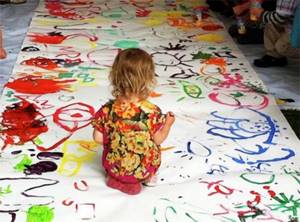
Psychology of eye drawing. I draw eyes, lips, nose - what the drawings mean.
Whenever I have a free minute, I always want to draw. I often draw eyes, lips, a flower (one), a nose.
Psychologist's answer.
Hello, Christina!
If you often draw eyes, lips, nose, and in other words, a person’s face, this may indicate an attempt to create an image of a successful, socially adapted person, which is done in order to compensate for your low self-esteem. That is, there is a strong concern about relationships with others, possibly with people of the opposite sex, as well as concern about one’s appearance. Those. you care how you look in the eyes of other people, what they think of you, how you are perceived.
Parts of the body located on the face provide sensory contact with reality.
Beautiful, well-drawn eyes indicate a desire to be attractive to other people.
Giving great importance to lips can be a sign of dependence and lack of independence. Beautifully drawn lips are narcissism.
A well-drawn nose indicates a high level of your libido.
The flowers in the drawings (or one flower) are drawn by those whose souls are not as cheerful as they might seem at first glance. Such people dream of tenderness; they lack love and attention.









